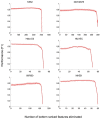Computational methods for the prediction of chromatin interaction and organization using sequence and epigenomic profiles
- PMID: 33454752
- PMCID: PMC8424394
- DOI: 10.1093/bib/bbaa405
Computational methods for the prediction of chromatin interaction and organization using sequence and epigenomic profiles
Abstract
The exploration of three-dimensional chromatin interaction and organization provides insight into mechanisms underlying gene regulation, cell differentiation and disease development. Advances in chromosome conformation capture technologies, such as high-throughput chromosome conformation capture (Hi-C) and chromatin interaction analysis by paired-end tag (ChIA-PET), have enabled the exploration of chromatin interaction and organization. However, high-resolution Hi-C and ChIA-PET data are only available for a limited number of cell lines, and their acquisition is costly, time consuming, laborious and affected by theoretical limitations. Increasing evidence shows that DNA sequence and epigenomic features are informative predictors of regulatory interaction and chromatin architecture. Based on these features, numerous computational methods have been developed for the prediction of chromatin interaction and organization, whereas they are not extensively applied in biomedical study. A systematical study to summarize and evaluate such methods is still needed to facilitate their application. Here, we summarize 48 computational methods for the prediction of chromatin interaction and organization using sequence and epigenomic profiles, categorize them and compare their performance. Besides, we provide a comprehensive guideline for the selection of suitable methods to predict chromatin interaction and organization based on available data and biological question of interest.
Keywords: DNA sequence and epigenomic features; gene regulation; methods evaluation; three-dimensional genome organization.
© The Author(s) 2021. Published by Oxford University Press.
Figures






Similar articles
-
De novo deciphering three-dimensional chromatin interaction and topological domains by wavelet transformation of epigenetic profiles.Nucleic Acids Res. 2016 Jun 20;44(11):e106. doi: 10.1093/nar/gkw225. Epub 2016 Apr 7. Nucleic Acids Res. 2016. PMID: 27060148 Free PMC article.
-
A Comparative Study of Supervised Machine Learning Algorithms for the Prediction of Long-Range Chromatin Interactions.Genes (Basel). 2020 Aug 24;11(9):985. doi: 10.3390/genes11090985. Genes (Basel). 2020. PMID: 32847102 Free PMC article.
-
A review of deep learning models for the prediction of chromatin interactions with DNA and epigenomic profiles.Brief Bioinform. 2024 Nov 22;26(1):bbae651. doi: 10.1093/bib/bbae651. Brief Bioinform. 2024. PMID: 39708837 Free PMC article. Review.
-
Methods for comparative ChIA-PET and Hi-C data analysis.Methods. 2020 Jan 1;170:69-74. doi: 10.1016/j.ymeth.2019.09.019. Epub 2019 Oct 16. Methods. 2020. PMID: 31629084 Review.
-
DeepChIA-PET: Accurately predicting ChIA-PET from Hi-C and ChIP-seq with deep dilated networks.PLoS Comput Biol. 2023 Jul 13;19(7):e1011307. doi: 10.1371/journal.pcbi.1011307. eCollection 2023 Jul. PLoS Comput Biol. 2023. PMID: 37440599 Free PMC article.
Cited by
-
Understanding the function of regulatory DNA interactions in the interpretation of non-coding GWAS variants.Front Cell Dev Biol. 2022 Aug 19;10:957292. doi: 10.3389/fcell.2022.957292. eCollection 2022. Front Cell Dev Biol. 2022. PMID: 36060805 Free PMC article. Review.
-
Integrative approaches based on genomic techniques in the functional studies on enhancers.Brief Bioinform. 2023 Nov 22;25(1):bbad442. doi: 10.1093/bib/bbad442. Brief Bioinform. 2023. PMID: 38048082 Free PMC article. Review.
-
InferLoop: leveraging single-cell chromatin accessibility for the signal of chromatin loop.Brief Bioinform. 2023 May 19;24(3):bbad166. doi: 10.1093/bib/bbad166. Brief Bioinform. 2023. PMID: 37139553 Free PMC article.
-
ChIPr: accurate prediction of cohesin-mediated 3D genome organization from 2D chromatin features.Genome Biol. 2024 Jan 12;25(1):15. doi: 10.1186/s13059-023-03158-7. Genome Biol. 2024. PMID: 38217027 Free PMC article.
-
Machine and deep learning methods for predicting 3D genome organization.ArXiv [Preprint]. 2024 Mar 4:arXiv:2403.03231v1. ArXiv. 2024. Update in: Methods Mol Biol. 2025;2856:357-400. doi: 10.1007/978-1-0716-4136-1_22. PMID: 38495565 Free PMC article. Updated. Preprint.
References
-
- Dekker J, Rippe K, Dekker M, et al. . Capturing chromosome conformation. Science 2002;295:1306–11. - PubMed
-
- Simonis M, Klous P, Splinter E, et al. . Nuclear organization of active and inactive chromatin domains uncovered by chromosome conformation capture-on-chip (4C). Nat Genet 2006;38:1348–54. - PubMed
Publication types
MeSH terms
Substances
LinkOut - more resources
Full Text Sources
Other Literature Sources

